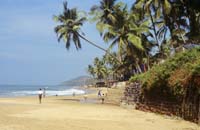 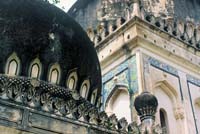 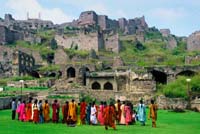 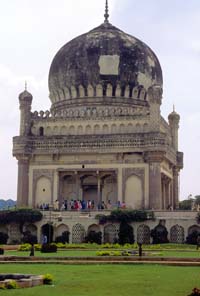 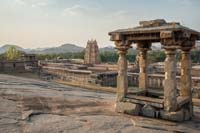 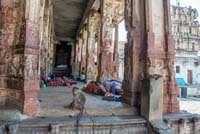 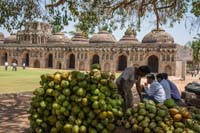 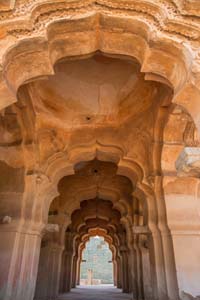 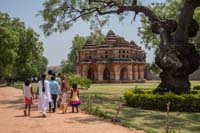 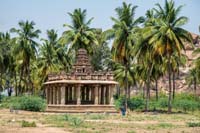 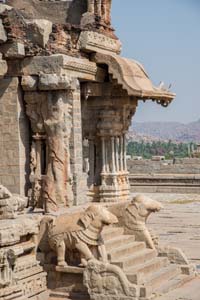 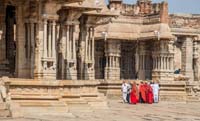 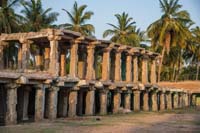 |
Kingdoms of Central India12 Days from Mumbai Day 1 – Depart for Aurangabad. There is a very early morning train from Mumbai that takes about 6 hours, or – if you prefer – there is a 45 minute flight. After you arrive in Aurangabad, have a short sightseeing trip out to the Bibi-ki-Maqbara, 1678 mausoleum of Begum Rabi’a Daurani, Aurangzeb’s wife. Intended to rival the Taj, it falls short, but is beautiful and impressive never the less. You could also visit Chalukyan Buddhist rock-cut caves just outside the city. Day 2 – Ellora (closed on Tuesdays) While Ajanta is more famous for its paintings, Ellora’s fame lies in the amazing sculptures, and are considered to be the best example of Deccan rock cut temple architecture. Excavated over a period of 400 years, these 34 caves were crafted out of the rock cliffs of the Chamadiri escarpment. Ellora has 17 Hindu caves which are located in more or less in the middle of the complex, around the awe inspiring Kailash Temple. This massive temple complex, a representation of Shiva’s abode on Mt Kailash, took thousands of workers 150 years to complete. The 12 Buddhist caves, located to the south of Kailash, are the oldest here, dating from about 500 AD to 750 AD. The Jain caves (9th and 10th centuries) are on the northern end of the escarpment and contain some wonderful carved halls. On the way back to Aurangabad, stop off to see the tomb of the Emperor Aurangzeb (ruled 1658-1707 ) at Khuldabad, and the immense fortress-city of Daulatabad, Day 3 – Ajanta (closed Mondays) These 28 caves, carved into the face of a cliff along a bend in the Waghora River, are one of India’s most extraordinary treasures. Started in the 2nd c. BC, most of the best carvings and paintings date from the 5th and 6th c. AD when this site was a flourishing Buddhist sanctuary with over 200 monks in residence. The caves were used as chaityas (halls of worship) and viharas (living and meditation quarters). Return to Aurangabad to catch the overnight train to Secunderabad, the railhead for Hyderabad. Day 4 – Arrive Hyderabad early in the morning. Check out the Salar Jung Museum (closed Fridays), full of the treasures collected by Salar Jang lll. Wonderful old Persian rugs, miniature paintings, objet d’art, and furniture are just a few of the things on display. The highlight of Hyderabad is the Golconda Fort, the old capital of the Qutb Shahi Kings. During its heyday in the 16th and 17th centuries, was one of the greatest forts of India, and even though it was badly damaged it is still a very impressive sight. Spilling down the side of a 400 ft high hill, it’s easy to see why this fort was so formidable. Take some time to visit the very photogenic Qutb Shahi tombs, (closed Fridays.) Day 5 – Drive to Gulbarga, about 6 hours. Gulbarga is a sleepy little town with, mostly used as a necessary overnight stop. It was the capital of the Bhamani Kingdom during the 14th c., so it does have a few interesting monuments. Probably the most interesting (if you are a man – women are not allowed to enter) is the tomb of Hazrat Gesu Daraz, known as The Dargah. This very pretty marble mausoleum is usually full of worshipers who come to seek the divine. There is also an old fort here in Gulbarga, but it is very ruined. Day 6 – Drive to Bijapur Bijapur was originally founded by the Chalukyas in the 10th c. when it was known as Vijayarura. It was also part of the Vijayanagar Kingdom before becoming the capital of the Muslim Adil Shahi Kings in 1489. Most of the outstanding architecture dates from this period. The city is chock full of ruined and semi-ruined tombs, mosques, and palaces, giving it the nickname of “The Agra of the South” It may not quite live up to that appellation, but there are at least 2 very impressive Moslim masterpieces here, The Gulgumbaz, the mausoleum of Muhammed Adil Shahi, is reputed to have the second largest dome in the world, superceded only by St. Peter’s Basilica. This huge, cavernous, monstrosity is a masterpiece of acoustical ingenuity, and it is said that one can hear a whisper spoken into the wall 38m. away on the other side. The other wonderful structure here is the Ibraham Rauza, tomb of Ibraham Adil Shah and his wife, Taj Sulatana. This place, built in about 1620, is truly a masterpiece of Islamic architecture, with beautifully carved stone jali windows, domes, minarets, cupolas, and Koranic inscriptions. But there will always be the occasional holy Hindu cow grazing in the grassy areas. Day 7 – Drive to Badami . Your first stop on the way to Badami is Aihole, the capital of the Chalukyan Kingdom in the 4th to the 6th c. Visit the Durga (but not the Goddess – it means “near the fort) Temple with rounded apse – is probably the most famous temple here. Be sure to climb to the top of the hill to see the vary famous Jain Meguti temple as well as some 120 temples lay scattered around this area A little further south is the WHS of Pattadakal, the ceremonial center for Chalukyan kings in the 7th and 8th c. “The main Virupaksha Temple massive columns, covered with intricate carvings depicting scenes from the Ramayana and Mahabharata. The rock hewn temples at Badami are reminiscent of the caves at Ellora and Ajanta. Even if you are a bit burned out on cave temples, it’s worth the climb for the views of the water tank below. Day 8 – Drive to Hospet. Sightseeing in Hampi, the ancient Vijayanagar capital. The population in its heyday was around 500,000. It was once the capital of the largest Hindu empire in Indian history. Founded in 1336, it controlled the peninsula south of the Krishna river, except a small bit along the Malabar coast. It was finally defeated by a confederacy of Deccan sultans in 1565. It will take most of the day to visit even the highlights of this immense ruined city. The temple center, known as Vitthala has several magnificent temples as well as famous stone chariot. The Zenana Enclosure contains the intricately carved Lotus Mahal – not to be missed, and the elephant stables are most impressive. At sunset, it’s a fairly easy climb up to the top of the rock hill behind the bazaar area to watch the sunset. Hotels – There are no real heritage hotels here. The Boulders is an “eco-wilderness” lodge but it’s about a 45 minute (beautiful) drive to Hampi. They have a boat that shortcuts across the river, but when I was there, slightly off season, it was no where to be found. The other option is to stay in one of the backpacker style guesthouses inside the ruins at Hampi Bazaar. I stayed at the Gopi and really enjoyed being so close to everything. The food at the Gopi was outstanding. Day 9 – Hampi A day to relax in Hampi and take in some of the sights you missed on the previous day. The bazaar area is full of inexpensive trinket shops, but the prices here are better than in the big cities. There are also a lot of good inexpensive restaurants that serve very yummy – other than Indian – food if you need a curry break. Day 10 – Drive to Goa It’s about a 6 hour drive to Goa. Day 11 – Goa Relax on the beautiful beaches of Goa Day 12 – Goa Have to morning to hang out and then catch the overnight train back to Mumbai. |
